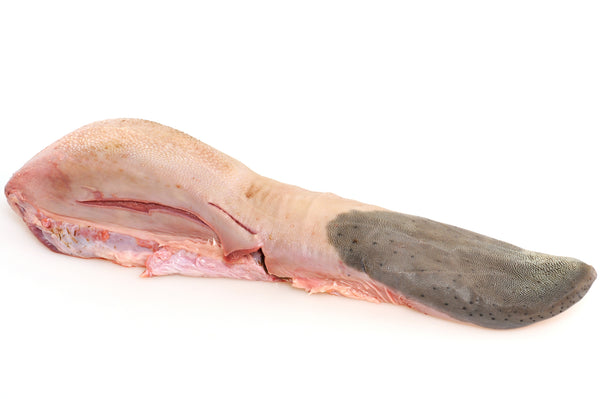What Is Muscle Meat?
A: These are the most common muscle meats used in the preparation of raw dog food
- Ox Heart
- Ox Tongue
- Beef Lung
- Beef Cheek
- Green Tripe
- Gizzards
- Uterus
- Pizzle
- Trachea
- Gullets
- Tendons
A complete and balanced raw dog food diet should consist of at least 75% muscle meat. In this article we talk about what the raw dog food community considers muscle meat for the purposes of raw food for dogs.
Here at Rawmate we take a nose-to-tail approach when it comes to the protein source for our high quality prepared raw dinners for dogs. We believe that it’s not only important to honour the source of the protein we use by reducing waste, we also take a great deal of care from a nutritional standpoint when it comes to providing our dogs with the widest range of nutrients possible.
Let’s have a look and see what each part of the animal provides, from tongue to tail.
Muscle Meats
Our ancestors didn’t waste anything when it came to making the most of the prey they hunted. Today, our tastes have changed and, with food readily available, we no longer make a point of finding ways to prepare beef heart or lamb lung. That’s too bad, because organ meats and some other less-frequently consumed parts are rich in certain nutrients.
Here’s a look at some of them and the benefits they provide.
We took a look at offal and wrote a blog about it called: What Is Offal?
Muscle Meat Rich in Protein and Other Nutrients
Muscle meat portions contain plenty of protein (with a complete selection of amino acids, particularly tryptophan and methionine), zinc, vitamins B2, B6, and B12, creatine, choline and iron. The B vitamins play an essential metabolic role in muscle growth and function and B12 facilitates nerve function, ensuring muscles are firing appropriately when needed.
Omega-3 fatty acids, selenium and magnesium are some of the other nutrients that can be found in varying proportions depending on the type of animal and the particular meat cut. Magnesium helps improve how efficiently the body uses vitamin D and plays a role in maintaining bone strength. Providing a wide range of cuts from different sources including beef, lamb, pork, fish and poultry helps ensure the best balance of nutrients.
Muscle Meat is Good for your Dog’s Heart and Circulation
The physiological benefits of consuming meat include preventing anemia and maintaining good cardiovascular health. Iron is essential for maintaining healthy hemoglobin levels in the blood, which allows efficient transport of oxygen to the cells and prevents anemia. The nutrients found in muscle meats are excellent for maintaining optimal strength and health of the heart. Selenium is an antioxidant which is believed to play a role in maintaining muscle cell health and helping in the repair process after hard work or injury.
Muscle Meat for Muscle Health
The heart isn’t the only thing that benefits from adequate meat in the diet. The protein and nutrients (especially zinc) found in meat are key to building and maintaining strong muscles in general as well as a healthy skin and coat. Zinc is also known to help with muscle cell repair and recovery and helps boost the immune system. If your dog is getting enough meat, she’ll have lots of energy to romp and play and her coat will develop a lovely naturally healthy sheen.
From Nose to Tail - Less Waste, Better Nutrition
Though we often overlook some of the less popular cuts of meat, there are plenty of health benefits from consuming all parts of the animal - from tongue to testicles! Cuts with lots of fat, gristle, cartilage and gelatine are rich in nutrients with plenty of benefits when it comes to maintaining bone health and being highly digestible.
Heart
The heart muscle is lean and powerful and provides a concentrated source of coenzyme Q10. Essential for cell function, CoQ10 also plays a role in heart health. Nutrient-dense, the heart is one of the best sources of nutrition when it comes to meat cuts. Particularly high in vitamin B12, that’s good news when it comes to supporting the enzymes that convert fat to energy. Rich in iron, the heart is a super useful ingredient when it comes to fuelling your dog’s energy needs (not only useful when it comes to the oxygen-carrying capacity of the blood, iron also boosts the immune system and is necessary for certain chemical reactions involved in the making of neurotransmitters).
Lung
Beef lung is a lean protein source that contains amino acids, iron, selenium and phosphorus. Though it probably won’t surprise you to know that it’s high in B vitamins (especially B12), you may not know that lung is also a source of vitamin C and also contains some zinc and copper. Not typically on the human menu (unless you like haggis and live somewhere that allows human consumption of lungs - but that’s a story for a different blog!), lung is an excellent ingredient when it comes to your dog’s dinner.
Cheek
Fatty and full of gelatine, cheek is highly palatable and very digestible. Often overlooked, cheek is rich in protein, iron, zinc and vitamin B12.
 Tongue
Tongue
Not a particularly high-calorie cut of meat, tongue is nevertheless a good source of protein and healthy unsaturated fats loaded with a full range of amino acids, zinc, iron, phosphorus and a little potassium. We’ve talked about the benefits of B vitamins and, it turns out, there are plenty of them in tongue.
Green Tripe
We’ve talked about tripe in detail in this blog post, but suffice it to say, the lining of a ruminant’s stomach (think cow, sheep, goat) is loaded with protein, along with some fat and carbohydrates. Tripe is a good source of selenium, an antioxidant protecting cells from damage caused by free radicals. A portion of tripe boosts immune and thyroid function and supports cell metabolism. Tripe also contains B vitamins and zinc.
Gizzards
Another great source of protein and iron, gizzards also contain vitamins B2, B3 and B12. Necessary for hormone production, maintaining circulatory health and nervous system function, these B vitamins are best obtained through whole food sources. Rich in zinc, iron, and phosphorous, gizzards are a handy addition to the meat cuts used in Rawmate meals.
Other cuts that are considered to be muscle meats in the context of dog food include uterus, pizzle, trachea, gullets and tendons. Each provides a slightly different nutrient profile and it’s by offering the broadest range possible that we ensure your dog gets all the vitamins, minerals, fatty acids, and macronutrients needed to maintain vitality and optimal health.
Offal - Sounds Awful, but Oh, So Good for Your Dog
Entrails, kidneys, liver, and tripe are all considered to be offal, offcuts that are too often disposed of as waste. And, what a waste that is!
Lets just say that by choosing to use these unsung heroes of meat cuts, Rawmate is not only providing the broadest possible nutritional profile for your dog, we are also doing our bit to reduce food waste. Win-win!
While it might not be that easy for you to track down such a wide range of protein sources, at Rawmate, we are passionate about sourcing the broadest range of ingredients for our high quality raw pet food for dogs.
If you have any questions, don’t be afraid to ask. Other members of the Rawmate pack may also be wondering and besides, we’d love to know what’s on your mind.




 Tongue
Tongue







There are 0 Comments